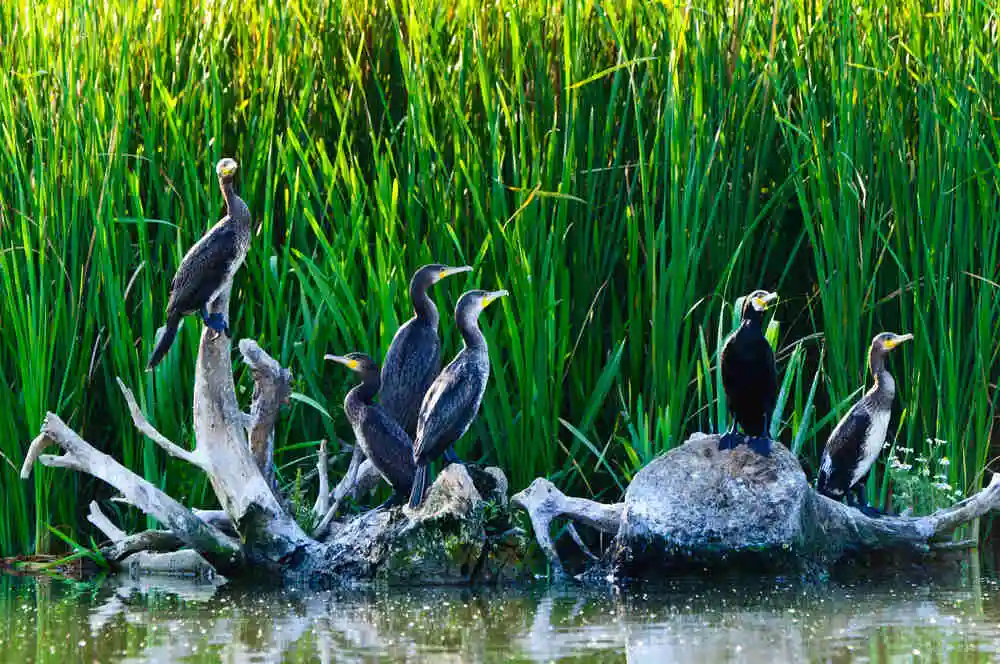Cuprins
The Danube Delta, one of Europe’s most fascinating nature reserves, unfolds like a vast labyrinth of canals, lakes and floating islands. An exceptional aquatic paradise and a sanctuary of biodiversity, this breathtaking place attracts adventure-seekers and nature lovers alike.
With its unparalleled variety of plant and animal species, the Danube Delta remains one of the most important nature reserves in Europe. In this enchanting landscape, rare birds, some of them endangered, find shelter and food, turning this corner of the world into a true paradise. Here you discover not only the wild beauty of the place, but also the deep connection between the winged creatures that inhabit it and their unique habitat.
The fascination with the birds of the Danube Delta remains one of the highlights of this breathtakingly beautiful area and offers the discerning visitor a rare opportunity to understand and appreciate the ecological complexity of one of the richest and most diverse natural regions on the planet.
If you would like to add bird watching to your holiday activities in the Danube Delta, here’s a useful guide to help you recognize and understand the birds that inhabit it.
- Sedentary bird species in the Danube Delta
- Migratory bird species in the Danube Delta
- Rare birds in the Danube Delta
- Endangered birds in the Danube Delta
- Useful birdwatching tips
Sedentary bird species in the Danube Delta
The Danube Delta is one of the most impressive and valuable ecosystems in Europe and even in the world. Covering some 5,165 square kilometers, the Danube Delta is the second largest delta in Europe, after the Volga Delta, and one of the best preserved on the continent. It expands by about 40 square meters every year due to continuous deposition.
It is a true paradise for birdwatchers and nature lovers, home to over 300 species of birds, many of which are rare or endangered worldwide. Around 170 of these species are hatching birds, which nest here, while the rest are migratory species that use the delta as a resting and feeding place during their annual migrations.
Many of the birds that live here have developed specific adaptations that allow them to thrive in the unique conditions of the delta and spend their entire lives in this region. The most important of these are:
Seagull
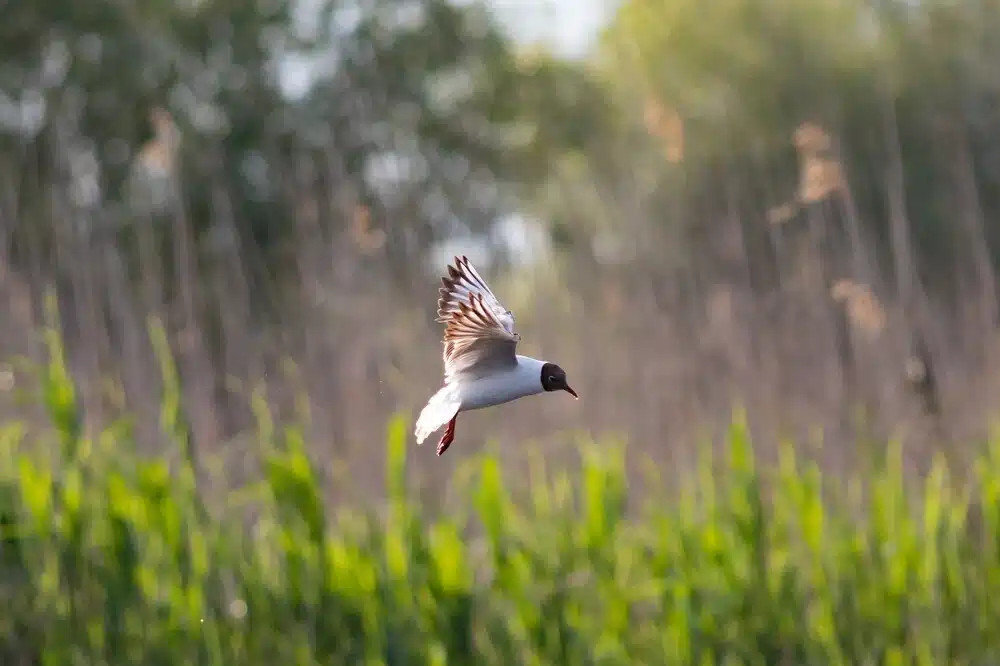
Seagull in the Danube Delta
With predominantly white and gray plumage and long, strong wings, they are adaptable and ubiquitous in the Danube Delta. They feed on a variety of foods, allowing them to survive in a variety of conditions. They are often seen hovering over the water or sitting on the banks, and their ecological role is significant, with gulls helping to clean up the ecosystem by consuming organic debris.
The heron
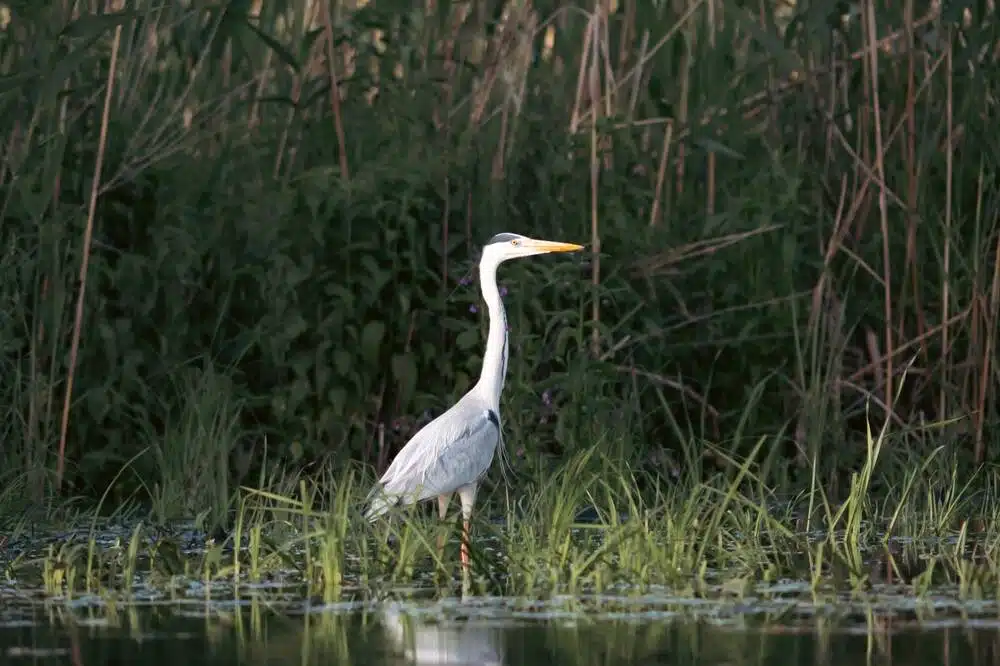
The heron in the Danube Delta
It is an elegant and slender bird and an outstanding resident of the delta. With its long legs and slender neck, the heron is perfectly adapted to hunting in the shallow waters of the delta. The grey heron can be seen sitting motionless in the reeds, waiting patiently for prey. Herons feed mainly on fish, amphibians and insects.
Cufundacul
With its hydrodynamic body and backward-positioned legs, the common loon is an efficient underwater swimmer and hunter. In the Danube Delta, the little grebe is a common sight, living in quiet lakes and canals. It feeds on small fish, aquatic insects and crustaceans, which it captures by diving quickly and accurately.
Whistle blower
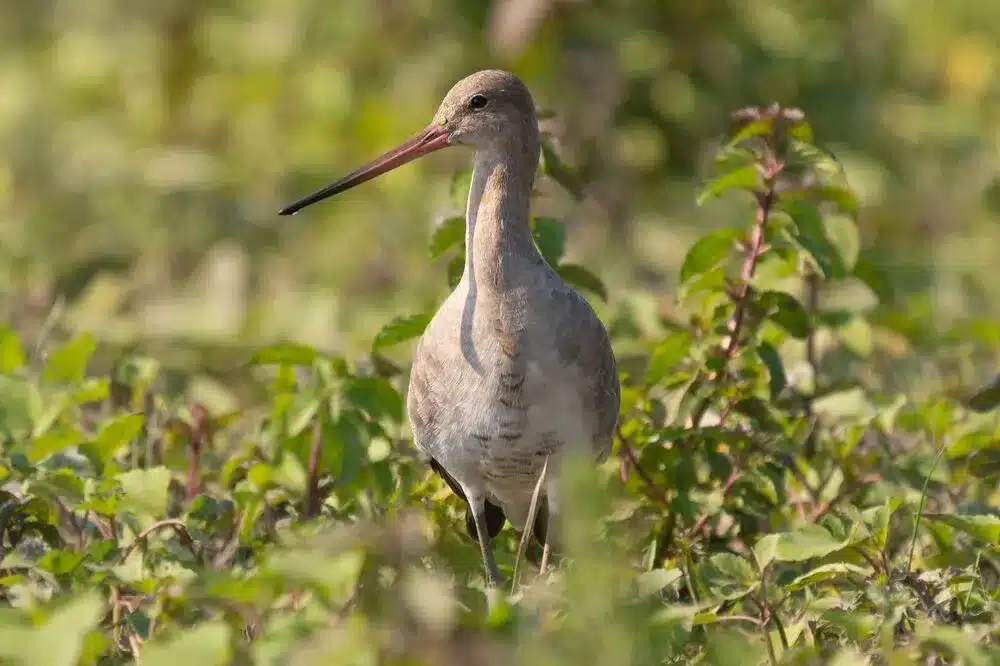
Whistle blower in the Danube Delta
The Whistler, a medium-sized bird with long, slender legs, is often found on sandy shores and wetlands of the delta. It is easily recognized by its distinctive calls and melodious song. It feeds on aquatic invertebrates, which it finds in moist soil and shallow water.
Other examples of sedentary birds are the common owl, the shoveler, the reed bunting and the reed bunting.
👉 If you are planning to relax in the Danube Delta and admire the wildlife of this fairytale place, at Green Dolphin Camping you will find accommodation in cottages, fresh air and plenty of peace and quiet. Equipped with the bare essentials, with a separate entrance and a small patio, they are just what you need for your long-dreamed-of getaway at the Danube’s spill into the sea.
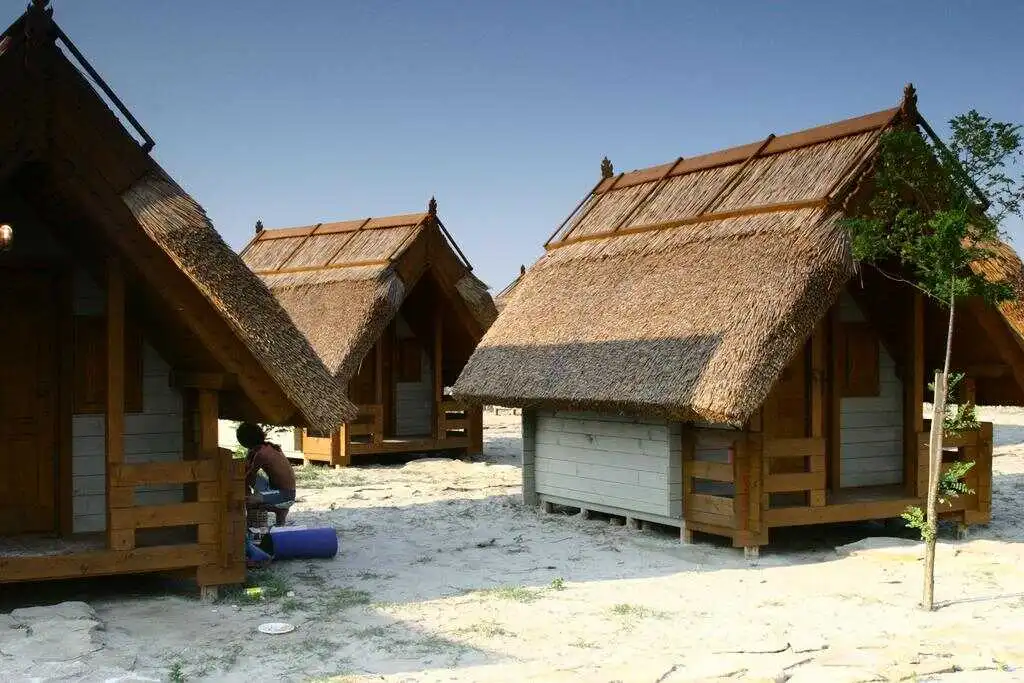
Cottage accommodation, Green Dolphin Camping
Migratory bird species in the Danube Delta
The delta’s migratory birds – some 130 species – play a vital role in maintaining the ecological balance of the Danube Delta. Here are some of the most important and most common:
Swan
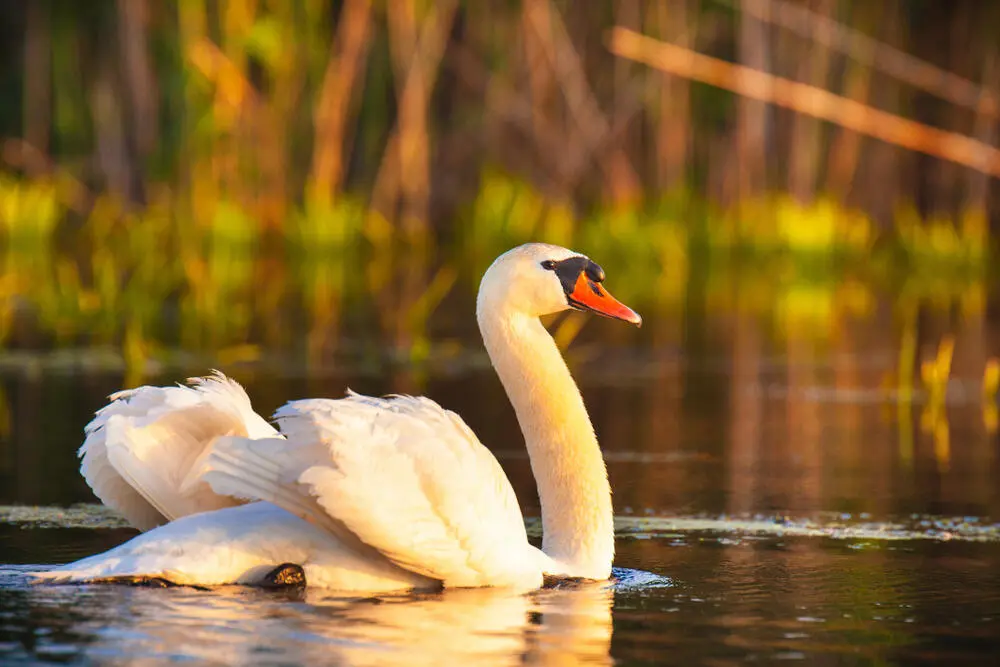
Swan in the Danube Delta
Symbols of grace and elegance, both winter and summer swans migrate to this natural sanctuary in search of favorable wintering or breeding conditions. They feed on aquatic plants, algae and small invertebrates, which they find in the shallows. They are truly an unforgettable sight for bird watchers.
Coker
It is one of the most imposing migratory birds visiting the Danube Delta. It travels thousands of kilometers from northern Europe to the warmer regions of the delta, where it finds ideal wintering conditions. It is recognized for its spectacular nuptial dances and its loud sounds that echo across the vast expanses of the delta. It feeds on seeds, insects and small vertebrates, contributing to the ecological balance of its temporary habitat.
Great Oyster
A nocturnal bird of prey and a seasonal visitor to the Danube Delta, with its large eyes and distinctive facial discs, the common loon is an efficient hunter, specializing in catching small mammals and smaller birds. It is harder to spot due to its nocturnal activity and inconspicuous behavior, but its presence is necessary to control rodent populations in the area.
Wild duck
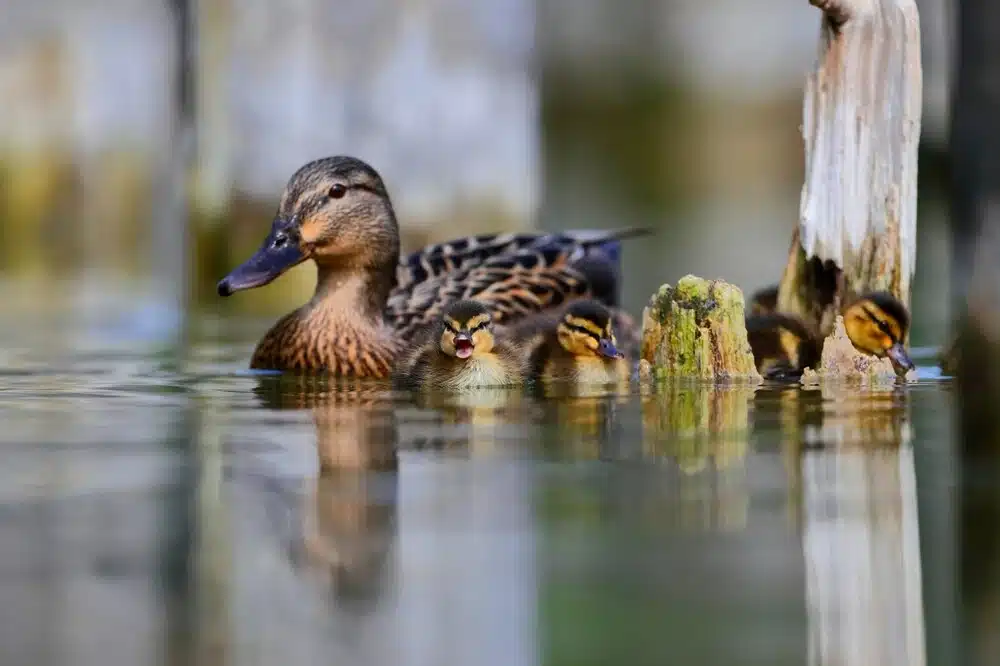
Wild duck in the Danube Delta
It takes refuge in the Danube Delta during seasonal migrations. It has a diversified plumage, with males having bright green heads and females a brownish-brown coloration, and adapts easily to different aquatic habitats. They feed on seeds, aquatic plants and invertebrates, and their presence in large numbers also attracts predators and other bird species, creating a complex and interdependent ecosystem.
Among the migratory birds that visit the delta each year are the white stork, wood duck, moorhen, red-backed lapwing, nuthatch, little egret, little tern and snipe.
👉 As spring and fall are the best seasons to get acquainted with the migratory birds that visit the Danube Delta every year, at Green Dolphin Camping you will find the best bird watching experience, which we offer you to gather beautiful memories and enjoy with your loved ones all the beauty of the deltaic fauna.
Rare birds in the Danube Delta
The Danube Delta is the ideal refuge for many rare bird species, providing them with a safe habitat and resources for survival. Their conservation requires efforts to protect their natural environment and reduce disturbance from human activities.
Here are some of the rare birds that can be spotted in the delta:
Crested Pelican
Of the rarest bird species in the Danube Delta, the crested pelican is certainly the most impressive. With its whitish plumage and wrinkled head flakes, it is a strikingly imposing bird with a wingspan of over 3 meters. It prefers to nest in large colonies on isolated islands in the delta, where it builds its nests from reeds and other plant material. It feeds mainly on fish, which it catches in its large, flexible beak.
Great white pelican
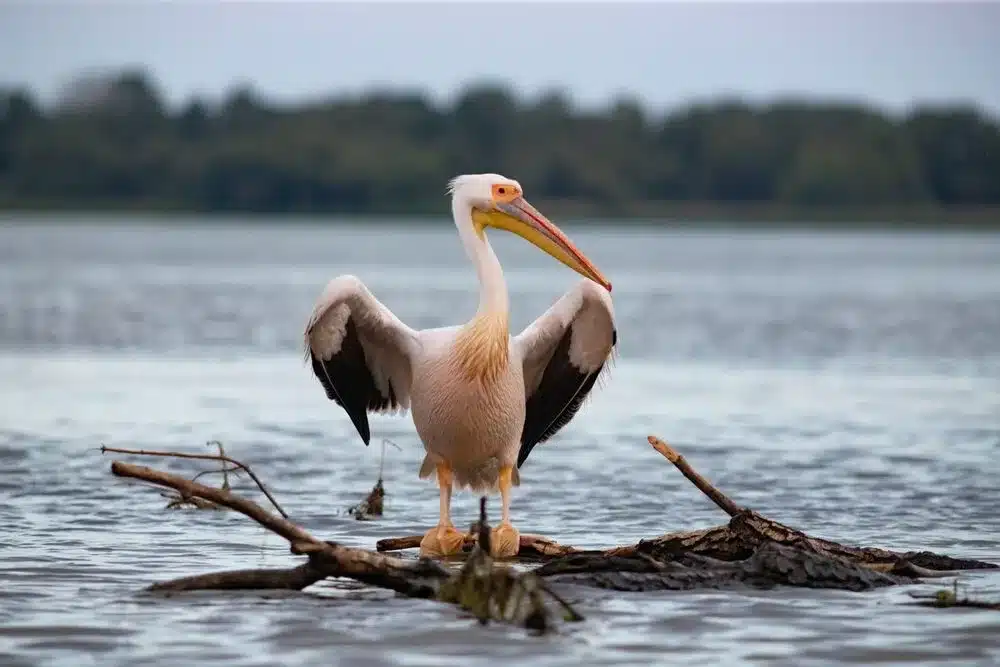
Pelican in the Danube Delta
It is another impressive resident of the Danube Delta, recognized for its brilliant white plumage and distinctive yellow bill. It lives in numerous colonies, often alongside the crested pelican, and spends its time fishing in the waters of the delta. It has a cooperative feeding strategy, working in groups to drive fish into shallower areas where they are easier to catch.
The night watchman
A rare and inconspicuous bird, mostly active at night, with dark gray plumage and bright red eyes, the night heron is perfectly adapted for hunting in the dark. It feeds on fish, amphibians and insects, which it catches in shallow water or in delta reedbeds. The night heron is secretive and nests in small colonies in protected areas of the delta where disturbance is minimal.
The codalb
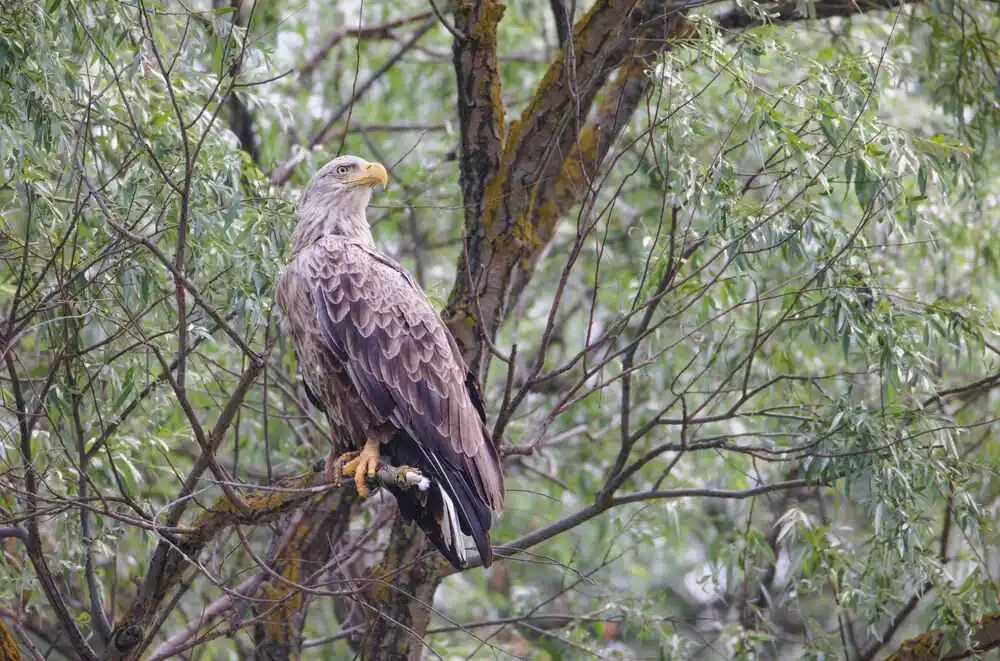
Codalb in the Danube Delta
Also known as the white-tailed eagle, it is one of Europe’s largest and most imposing birds of prey. With a wingspan of up to 2.5m and a brownish plumage with a distinctive white tail, the kotail is an efficient hunter, feeding on fish, water birds and small mammals. It prefers to nest in tall, isolated trees away from human activity. With its abundance of food and safe nesting sites, the Danube Delta provides the ideal breeding habitat.
Red-necked goose
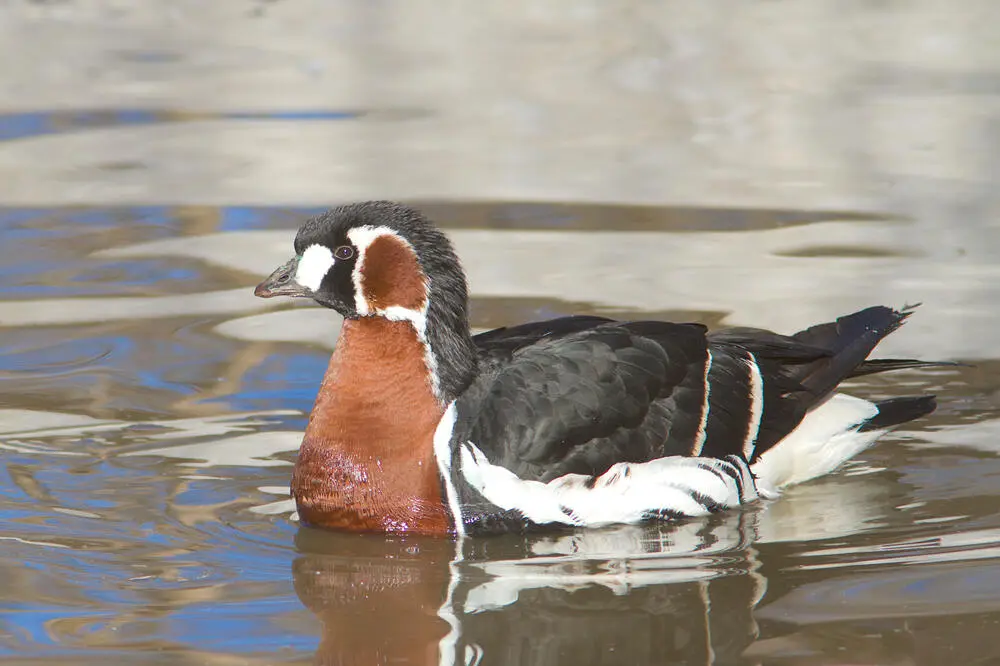
Red-necked goose in the Danube Delta
It is one of the rarest and most endangered species of geese in the world, and the Danube Delta is its ideal wintering site. It has a distinctive reddish-brown plumage on its neck, and migrates from the Arctic tundra to find milder wintering conditions in the delta. It feeds mainly on grasses, seeds and aquatic plants. Its population is declining due to habitat loss and poaching, and protecting its wintering grounds and feeding areas is critical to the conservation of this vulnerable species.
Great Cormorant
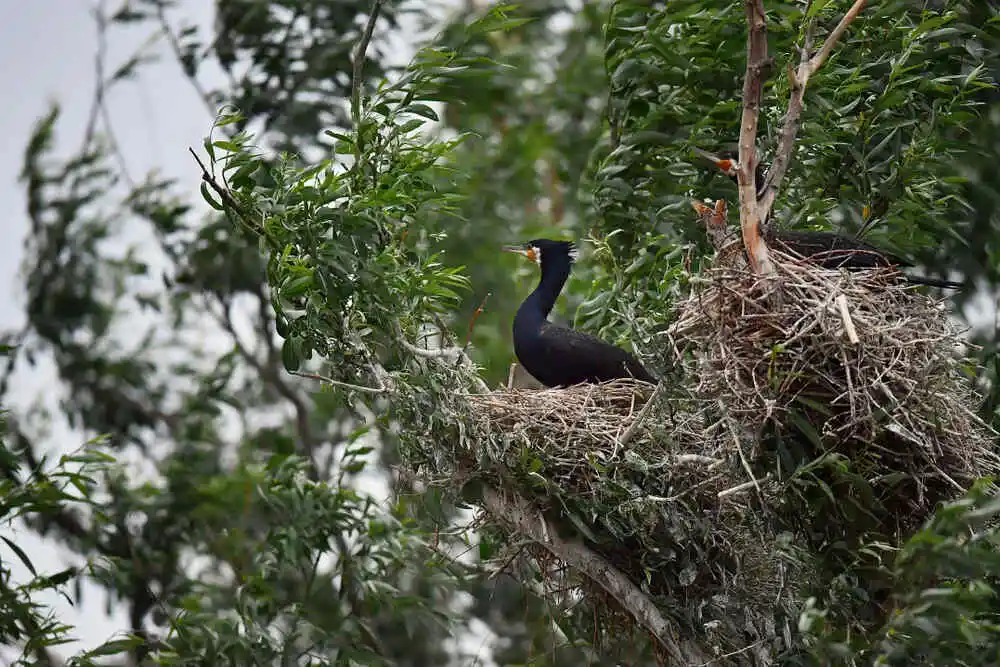
Cormorant nesting in the Danube Delta
A robust and adaptable aquatic bird, it is easily recognized by its black plumage and bright green eyes. Great cormorants are excellent fishermen, diving into the water to catch fish with their powerful, sharp beaks. They nest in large colonies, on isolated islands or in tall trees, and their presence in the area is an indicator of a healthy aquatic ecosystem.
Shoveler’s pole
It is a rare and spectacular bird, easily recognizable by its long, broad beak, resembling a small shovel. This unique adaptation allows it to feed efficiently in the shallow waters of the delta, filtering mud and water to catch small fish, crustaceans and insects. With its pristine white plumage and elegant stature, the shovelnose tern is a graceful presence in the Danube Delta, and a moment worth immortalizing when you meet it.
The great Egreta
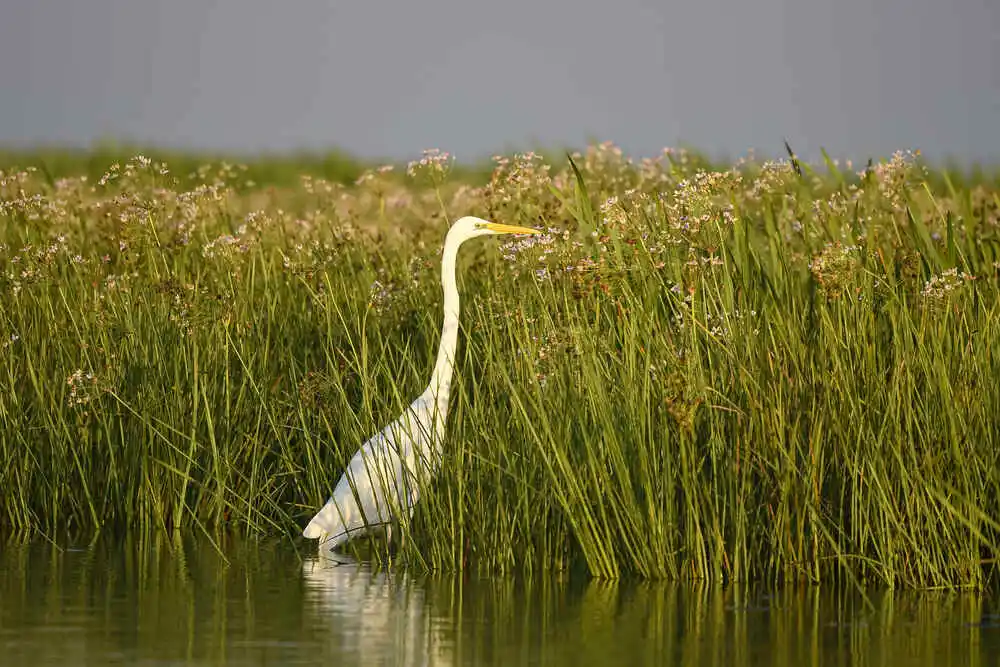
Great Egret in the Danube Delta
With its long legs and yellow beak, the great egret is a skillful hunter, feeding on fish, amphibians and insects in the shallow waters of the delta. It forms nesting colonies in dense reedbeds and trees on isolated islands. It is easily recognizable, especially because of its size, which distinguishes it from the little egret.
👉 The rare birds of the Delta hide in unexpected places. If you want to observe them and enjoy the view of their natural habitat, Green Dolphin Camping invites you on a boat trip among the beaches and islets, so you can observe their colors and their free flight from the deck.
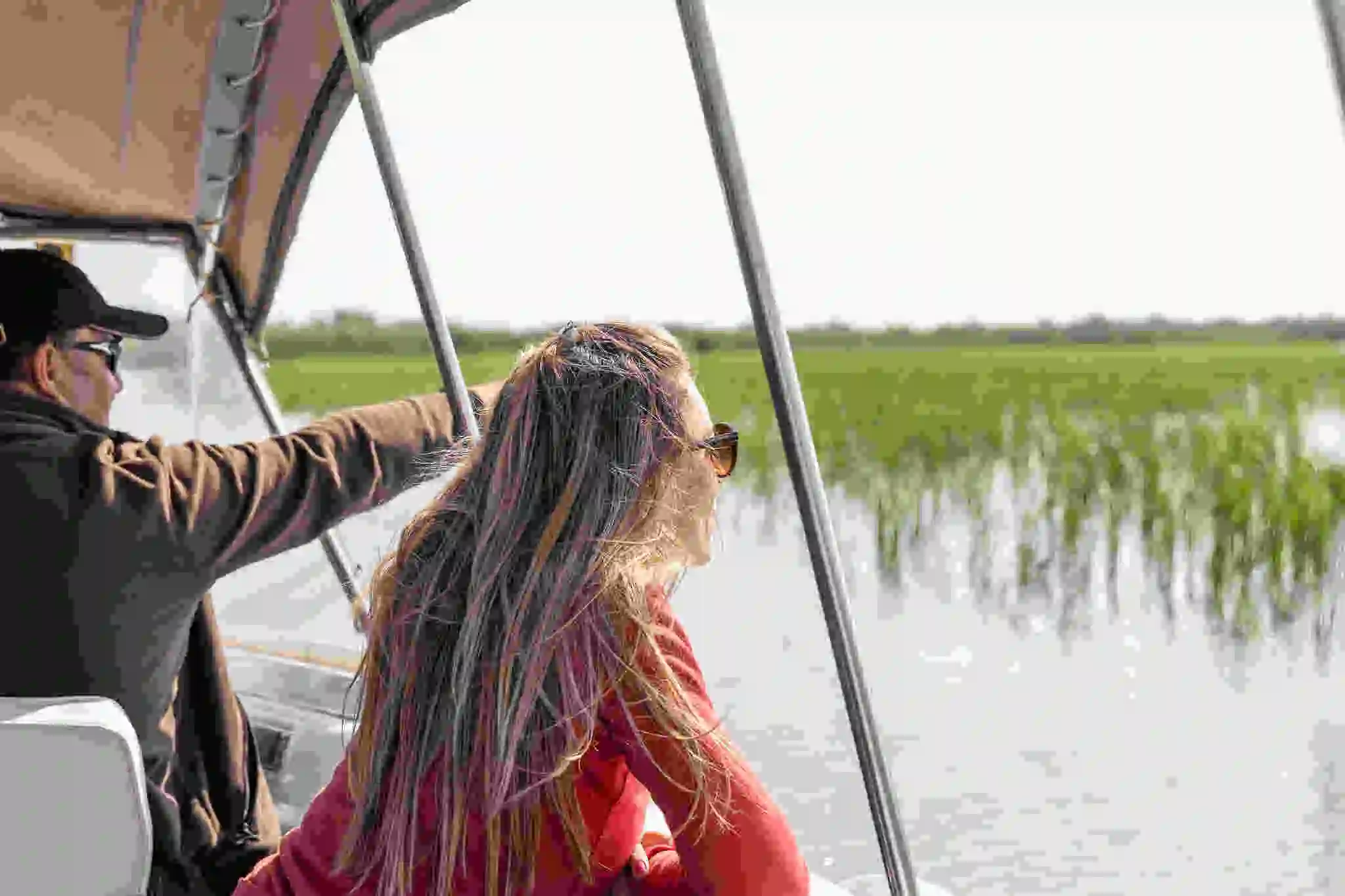
Boat trip, Green Dolphin Camping
Endangered birds in the Danube Delta
Unfortunately, some of the bird species that nest permanently in the delta or migrate here year after year are considered vulnerable species, facing numerous threats ranging from habitat loss and pollution to climate change and poaching.
Most of the rare birds of the Danube Delta, such as the curlew pelican and the common tern, face these threats, but other species are also threatened with extinction, including the following:
The Gypsy
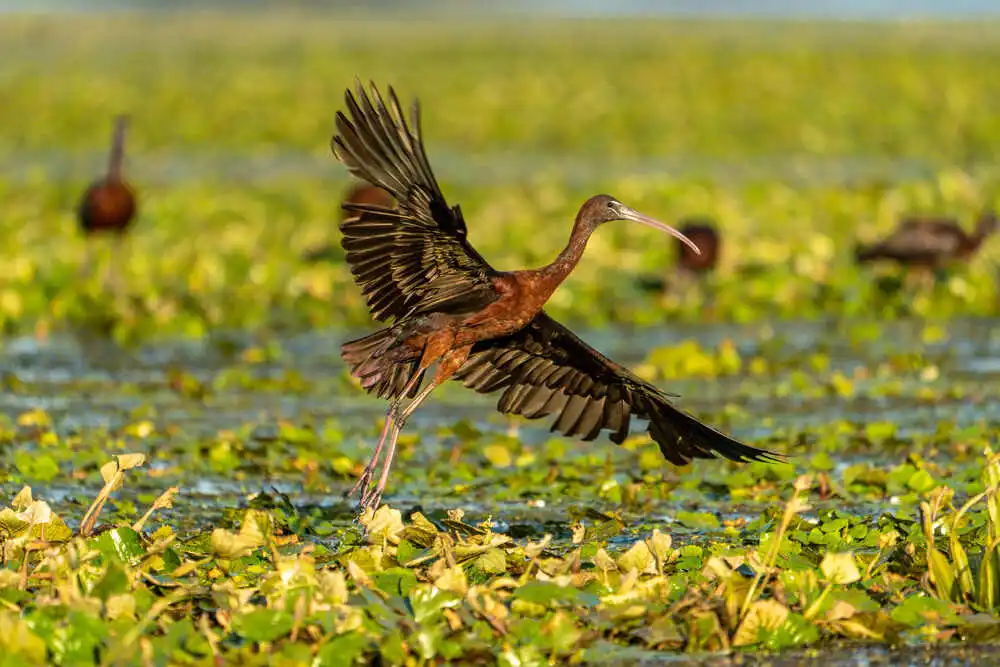
A little dancer in the Danube Delta
Known in English as the glossy ibis, this bird is easily recognizable by its iridescent plumage and long, curved beak, which gives it an elegant and enigmatic appearance.
Its plumage ranges from dark brown to black, but in sunlight its feathers glow in shades of green, purple and dark gold, creating a visually stunning display. Its long, curved beak is a perfect tool for burrowing in mud and water, allowing it to catch hidden prey. These birds are often seen feeding in groups, using their foraging skills in a coordinated and efficient way.
The species is facing multiple threats to its existence: wetland degradation, pollution, climate change and out-of-control human activities are just some of the major challenges.
Sea Saker falcon
It is one of the rarest and most impressive predators in the Danube Delta. With its large size and agile flight, it is known for its ability to capture birds and small mammals in flight. Its light-brown plumage, with dark stripes and spots, provides effective camouflage in the open landscapes of the delta. Unfortunately, the Danube falcon faces multiple threats, including habitat loss, poaching and the use of pesticides that reduce prey availability.
Dwarf cormorant
This small, delicate waterbird, unlike the great cormorant, is smaller in stature and has a dark plumage with metallic green highlights. It is a fast underwater hunter, diving to catch small fish and other organisms living in the water. They feed in dense colonies in reed vegetation, where they are vulnerable to disturbance and habitat loss.
Red duck
Also known as the Brown-headed Duck, it is a small duck species with a distinctive reddish-brown plumage. It prefers lakes and lagoons with abundant vegetation, where it feeds on seeds, aquatic plants and invertebrates.
Little Egret
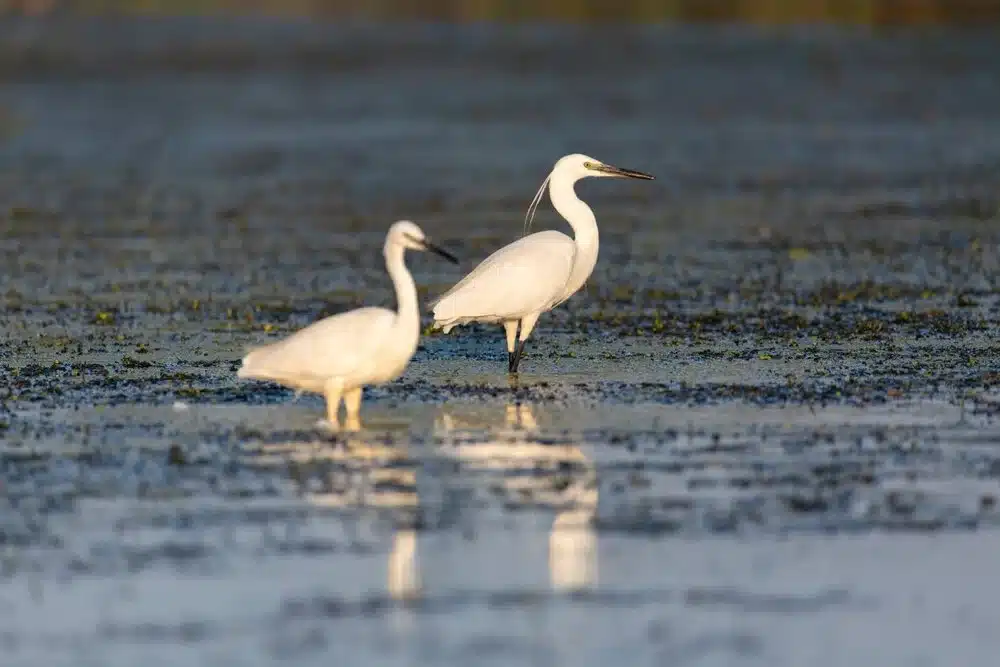
Little Egret in the Danube Delta
It’s an elegant bird with a pristine white plumage and black legs finished with yellow claws. These distinctive features make the little egret a recognizable and admired presence. Little egrets feed in shallow water, where they catch fish, amphibians and insects. They nest in tall colonies in trees or dense bushes.
👉 There’s one place in the Danube Delta where the curly pelican calls home: Letea Forest. If you want to see it in its natural environment and learn more about this magical place, read our article “Letea Forest – Paradise in the heart of the Danube Delta“.
Useful birdwatching tips
It’s hard to find a better place for birdwatching than the Danube Delta. Even if you’re not a bird-watching enthusiast or you’re a first-timer, the following tips can help you enjoy the wildlife in the area, whether you’re alone, with a couple or with the whole family.
- Invest in quality binoculars so you can observe bird details without disturbing them, and if you want to capture images of the winged birds, a telephoto camera is ideal.
- Spring and fall are the best times to spot migratory birds, while summer and winter are best for sedentary species.
- The reed forests, lakes and canals of the delta are excellent places for birdwatching, as are the pontoons or observation towers where they exist.
- Observe birds from a distance to avoid stressing them or disturbing their natural activities, and avoid loud noises and sudden movements that might startle them.
- Involve the little ones by asking them to keep a bird-watching diary or draw pictures of the birds they see. Use the opportunity to educate them about the importance of biodiversity and habitat conservation and keep a close eye on them, especially near water or in hard-to-reach areas.
- Birdwatching takes patience. Pay attention to the sounds and movements around you, take photographs and make notes about the birds you see – they are useful for species identification and will turn into unforgettable memories.
As we explore and admire the birds of the Danube Delta, we are invited to reflect on the fragility and resilience of nature, to commit ourselves to its protection and to deeply appreciate the essential role these wonderful creatures play in our lives and the health of the planet. The Danube Delta is not just a habitat, but a living testament to the power of nature to create and sustain life in its most diverse forms.
Photo source: Green Dolphin Camping, Shutterstock, Shutterstock, Shutterstock

